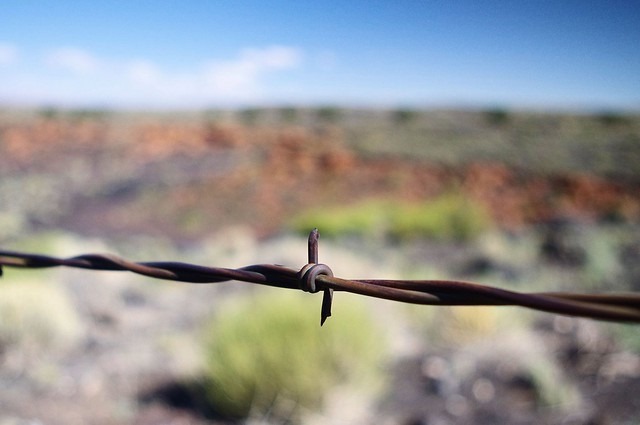Royalty-free images by Mike1 — No. 85 of over 1200 images

Barbed wire, between Sunset Crater Volcano National Monument and Wupatki National Monument, north-central Arizona, near Flagstaff, October 6, 2011
Barbed wire (Wikipedia)
Barbed wire, also known as barb wire, occasionally corrupted as bobbed wire or bob wire, is a type of steel fencing wire constructed with sharp edges or points arranged at intervals along the strands. It is used to construct inexpensive fences and is used atop walls surrounding secured property. It is also a major feature of the fortifications in trench warfare (as a wire obstacle).
A person or animal trying to pass through or over barbed wire will suffer discomfort and possibly injury (this is especially true if the fence is also electric). Barbed wire fencing requires only fence posts, wire, and fixing devices such as staples. It is simple to construct and quick to erect, even by an unskilled person.
The first patent in the United States for barbed wire was issued in 1867 to Lucien B. Smith of Kent, Ohio, who is regarded as the inventor. Joseph F. Glidden of DeKalb, Illinois, received a patent for the modern invention in 1874 after he made his own modifications to previous versions.
Barbed wire was the first wire technology capable of restraining cattle. Wire fences were cheaper and easier to erect than their alternatives. (One such alternative was Osage orange, a thorny bush that was time-consuming to transplant and grow.) When wire fences became widely available in the United States in the late 19th century, it became more affordable to fence much larger areas than before, and intensive animal husbandry was made practical on a much larger scale.
An example of the costs of fencing with lumber immediately prior to the invention of barbed wire can be found with the first farmers in the Fresno, California, area, who spent nearly $4,000 (equivalent to $85,000 in 2019) to have wood for fencing delivered and erected to protect 2,500 acres (1,000 ha) of wheat crop from free-ranging livestock in 1872.
- I am sharing some of my public domain images in periodic blog posts.
-
- This image is also shared as public domain on Pixabay and Flickr.
- Images are being shared in the sequence they were accepted by Pixabay, a royalty-free image sharing site.
- Only images specifically identified as such are public domain or creative commons on our pages.
- All other images are copyright protected by me, creative commons, or used under the provisions of fair use.

